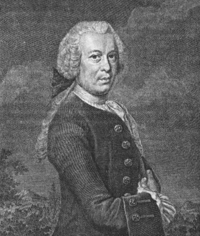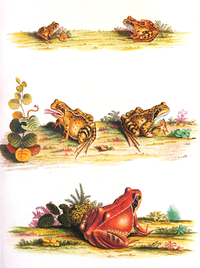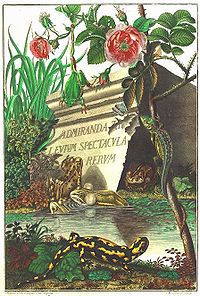
August Johann Rösel von Rosenhof
Encyclopedia



Arnstadt
Arnstadt is a town in Ilm-Kreis, Thuringia, Germany, situated on the Gera River. It is one of the oldest towns in Thuringia and is nicknamed Das Tor zum Thüringer Wald, The Gate to the Thuringian Forest....
– March 27 , 1759 in Nuremberg
Nuremberg
Nuremberg[p] is a city in the German state of Bavaria, in the administrative region of Middle Franconia. Situated on the Pegnitz river and the Rhine–Main–Danube Canal, it is located about north of Munich and is Franconia's largest city. The population is 505,664...
) was a German miniature
Miniature (illuminated manuscript)
The word miniature, derived from the Latin minium, red lead, is a picture in an ancient or medieval illuminated manuscript; the simple decoration of the early codices having been miniated or delineated with that pigment...
painter, naturalist
Natural history
Natural history is the scientific research of plants or animals, leaning more towards observational rather than experimental methods of study, and encompasses more research published in magazines than in academic journals. Grouped among the natural sciences, natural history is the systematic study...
and entomologist. With his accurate, heavily detailed images of insects he was recognised as an important figure in modern entomology
Entomology
Entomology is the scientific study of insects, a branch of arthropodology...
.
Life
Descendant of a "noble family of Austria", Rösel was born August Johannes Rösel. This was modified in 1853, undoubtedly in the honour of his uncle, the animal painter Wilhelm Rösel von Rosenhof. Rösel’s father died when he was very young and it was his uncle who gave him an artistic education after his godmother, the princess Augusta Dorothea von Arnstadt-Schwarzburg, had detected his talent. He continued art studies of art at the Academy of Nuremberg (1724-1726) where he became a very gifted painter of portraits and miniatures, which enabled him to join the DanishDenmark
Denmark is a Scandinavian country in Northern Europe. The countries of Denmark and Greenland, as well as the Faroe Islands, constitute the Kingdom of Denmark . It is the southernmost of the Nordic countries, southwest of Sweden and south of Norway, and bordered to the south by Germany. Denmark...
court of Copenhagen
Copenhagen
Copenhagen is the capital and largest city of Denmark, with an urban population of 1,199,224 and a metropolitan population of 1,930,260 . With the completion of the transnational Øresund Bridge in 2000, Copenhagen has become the centre of the increasingly integrating Øresund Region...
in 1726. There he remained two years before returning to Germany, once more to Nuremberg.
Recovering from a disease, he discovered the work of Anna Maria Sibylla Merian, Metamorphosis insectorum Surinamensium (1647-1717) in which she described the insects and other animals which she observed in Surinam. Rösel conceived the idea to write and illustrate a similar book on the German fauna.
In 1737, he married Elisabeth Maria, the daughter of the surgeon, physiologist and poet Michael Bertram Rosa. His artistic talent gave him a very good reputation so that he lived comfortably while painting and he could use his spare time to observe insects, amphibians and reptiles in nature. He collected eggs and larvae in order to raise them at home and to study their development and their metamorphoses. His detailed observations, more useful by being accompnied by very beautiful illustrations, were published in two large books. The first, Insecten-Belustigung, appeared in 1740 and was devoted to the insects and other invertebrates like the sea anemones. His classification of the insects followed a natural system and he is regarded as one of the fathers of German entomology. The fourth part is practically a monograph of the spider Araneus diadematus. The description of the animal is illustrated by six plates which show the differences in variation of the colouring of the species. They show also internal dissections. Rosenhof was interested in the production of silk but he confused the anus with the opening of silk-producing glands.
He published, between 1753 and 1758, Historia naturalis Ranarum nostratium devoted to frogs. The quality of the work, in particular of its illustrations, make it one of the most beautiful devoted to these animals. He presented the life cycle of all the species of Germany, and their anatomy and their osteology. The second part of the work, appeared in 1758. It is prefaced by Albrecht von Haller
Albrecht von Haller
Albrecht von Haller was a Swiss anatomist, physiologist, naturalist and poet.-Early life:He was born of an old Swiss family at Bern. Prevented by long-continued ill-health from taking part in boyish sports, he had the more opportunity for the development of his precocious mind...
(1708-1777).
He then started a similar work on the lizards and the salamanders but a cerebral attack paralysed him and he died a little later on March 27, 1759. Many descriptions of species made by Carl von Linné are based on the descriptions given by Rösel.
Roesel's bush-cricket
Roesel's bush-cricket
Roesel's bush-cricket is a European bush-cricket, named after August Johann Rösel von Rosenhof, a German entomologist.Its song is very similar to that of Savi's Warbler.-Morphology:-Adult insects:...
Metrioptera roeseli was so named in his honour.
Works
- Insecten-Belustigung (1740)
- Historia naturalis Ranarum nostratium/Die natürliche Historie der Frösche hiesigen Landes(1758)
- Insecten-Belustigung(1740)
External links
- Historia naturalis ranarum nostratium at SICD Universities of Strasbourg Digital Old Books.
- Rosenhof Plates
- Plates from Insecten-Belustigung at the University of Copenhagen library
in progress
Source
- Translated from French Wikipedia
- Kraig Adler (1989) Contributions to the History of Herpetology, S.S.A.R.

